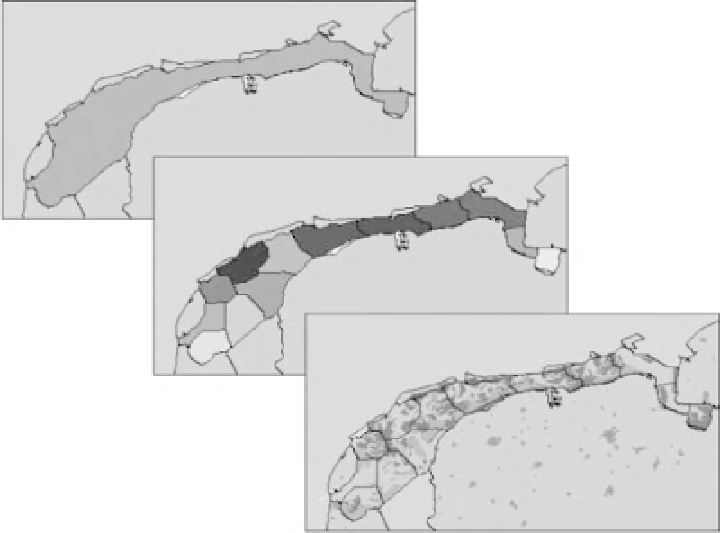Environmental Engineering Reference
In-Depth Information
For the technical implementation ofWadBOS the DSS-
Generator GEONAMICA
was used. A DSS Generator
is '
a package of hardware/software which provides a set
of capabilities to build specific DSS[s] quickly and easily
'
(Sprague and Carlson, 1982). Hence, it concerns a special
purpose software-development environment for the cre-
ation of new DSS applications in a more or less narrowly
defined domain. GEONAMICA
is an
object-oriented
application framework
, developed by RIKS bv. It is spe-
cially geared towards developing spatial DSS featuring
models that run at multiple spatial and temporal resolu-
tions. Typically it will combine
system dynamics
models
and
cellular models
for this purpose. In particular, use is
made of
spatial interaction-based models
, different kinds
of
cellular automata models, multi-agent
or other kinds
of
rule-based models
. It is equipped with highly efficient
computational techniques and algorithms for addressing
spatial problems, but also with additional analytical tools,
visualization tools, and input, import, export and output
tools (see 'The Toolbase' section below).
scales: (1) the Wadden Sea as a whole (c. 3000 km
2
),
(2) the 12 compartments within the sea (mostly delim-
ited on the basis of hydrodynamic characteristics), or
(3) a regular grid consisting of c. 11 000 cells of 25 ha
each (see Figure 21.2). As for the temporal resolution,
WadBOS integrates submodels running at (1) a yearly
and (2) a monthly time step, or (3) a time step equal
to the tidal cycle. The model represents strongly cou-
pled social, economic, ecological, biological, physical and
chemical processes (see Figure 21.3). They are grouped
into three main submodels: the
Economy
,the
Ecology
and
Landscape
. Enough existing GIS and statistical data are
available to run its economic and ecological models. It is
sufficient to generate the output required for most rele-
vant policy questions, it meets the performance criteria
specified and it performs a simulation run of 10 years
in less than 10 minutes on a state-of-the-art PC with
Windows installed.
Most economic processes run on a monthly or yearly
time step, while most of the ecological processes are
represented at the compartment level and run on a tidal
cycle time step. Figure 21.3 shows the system diagram of
the integrated model at the highest level of abstraction.
This diagram is also the user interface of the model (see
below). The boxes represent submodels and the arrows
between the boxes show the main data flows in the model.
21.5 The integrated WadBOS model
The WadBOS model resulting from the exercise consists
of submodels running at one of three embedded spatial
Figure 21.2
WadBOS integrates submodels running at one of three spatial scales: the whole Wadden Sea, 12 Compartments, or
11 000 cells of 25 ha each.




Search WWH ::

Custom Search